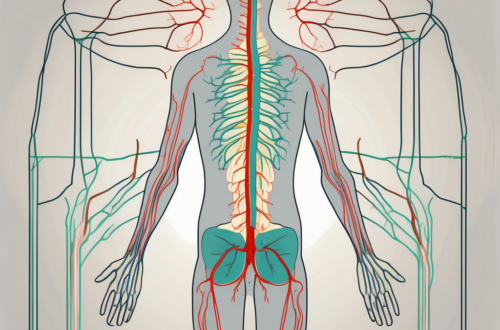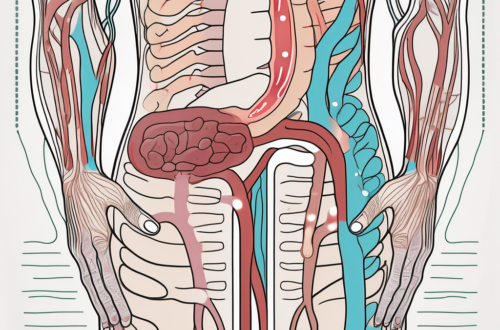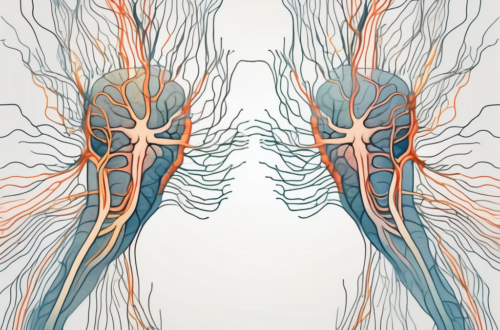The parasympathetic nerve synapse is a crucial component of the intricate network known as the nervous system. Its role in regulating bodily functions cannot be overstated. To truly grasp its significance, we must first gain a holistic understanding of the nervous system as a whole.
An Overview of the Nervous System
The nervous system serves as the command center of our bodies, coordinating and controlling all of our bodily functions. It can be divided into two major components: the central nervous system (CNS) and the peripheral nervous system (PNS). The CNS consists of the brain and spinal cord, while the PNS encompasses the network of nerves that extend throughout the body.
The central nervous system, composed of the brain and spinal cord, is responsible for processing and interpreting information received from the peripheral nervous system. It is like the control room of our body, analyzing sensory input and sending out appropriate signals to initiate motor responses.
The peripheral nervous system, on the other hand, is responsible for connecting the central nervous system to the rest of the body. It consists of a vast network of nerves that transmit information from sensory receptors to the brain and spinal cord, and then relay motor commands back to the muscles and organs.
The Role of the Parasympathetic Nervous System
Within the PNS, the parasympathetic nervous system plays a vital role in maintaining homeostasis. It works in opposition to the sympathetic nervous system, which triggers the body’s fight-or-flight response. While the sympathetic nervous system prepares the body for action, the parasympathetic nervous system promotes rest, relaxation, and digestion.
When the parasympathetic nervous system is activated, it slows down heart rate, constricts blood vessels, and stimulates digestion. This allows the body to conserve energy and focus on essential functions such as nutrient absorption and tissue repair. In contrast, the sympathetic nervous system increases heart rate, dilates blood vessels, and redirects blood flow to the muscles, preparing the body for physical exertion.
Both the sympathetic and parasympathetic nervous systems work together to maintain a delicate balance in the body, ensuring that the appropriate response is activated in different situations. For example, during a stressful event, the sympathetic nervous system takes over, while the parasympathetic nervous system dominates during periods of rest and recovery.
The Structure of the Nervous System
The nervous system is composed of cells called neurons, which transmit electrical signals throughout the body. Neurons consist of several key components, including the cell body, dendrites, axons, and synapses. These components work together to facilitate the transmission of information from one neuron to another.
The cell body, also known as the soma, contains the nucleus and other organelles necessary for the neuron’s survival and functioning. Dendrites are branching extensions that receive signals from other neurons and transmit them towards the cell body. Axons, on the other hand, are long, slender projections that carry signals away from the cell body and transmit them to other neurons or target cells.
At the synapse, which is the junction between two neurons, the magic of neurotransmission occurs. When an electrical signal reaches the end of an axon, it triggers the release of chemical messengers called neurotransmitters. These neurotransmitters then bind to receptors on the dendrites or cell bodies of neighboring neurons, transmitting the signal across the synapse.
The structure of the nervous system is incredibly intricate, with billions of neurons and trillions of synapses working together to ensure proper communication and coordination within the body. It is this complexity that allows us to perceive the world, think, move, and experience emotions.
The Anatomy of a Synapse
At its core, a synapse is the junction between two neurons. It is within this small gap that the crucial transfer of information takes place.
The synapse is a complex structure that plays a vital role in the communication between neurons. Let’s take a closer look at the different components involved:
The Pre-Synaptic Neuron
The pre-synaptic neuron is the one sending the signal. When an electrical impulse reaches the end of this neuron’s axon, it stimulates the release of chemical messengers known as neurotransmitters.
Neurotransmitters are stored in small sacs called synaptic vesicles, which are located in the terminal buttons of the pre-synaptic neuron. When the electrical impulse reaches the terminal buttons, it triggers a series of events that cause the synaptic vesicles to fuse with the pre-synaptic membrane, releasing the neurotransmitters into the synapse.
Each pre-synaptic neuron can release multiple types of neurotransmitters, each with its own specific function. Some neurotransmitters, such as dopamine and serotonin, are involved in regulating mood and emotions, while others, like acetylcholine, play a role in muscle movement.
The Post-Synaptic Neuron
The post-synaptic neuron is the one receiving the signal. It possesses specialized receptor molecules on its surface that can detect and bind to specific neurotransmitters released by the pre-synaptic neuron. This binding triggers a series of events that propagates the signal further along the neural pathway.
Once the neurotransmitters are released into the synapse, they diffuse across the gap and bind to the receptors on the post-synaptic neuron. These receptors are highly specific, meaning that only certain neurotransmitters can bind to them. This specificity ensures that the correct signals are transmitted between neurons.
When a neurotransmitter binds to its receptor, it can either excite or inhibit the post-synaptic neuron. Excitatory neurotransmitters increase the likelihood that the post-synaptic neuron will generate an electrical impulse, while inhibitory neurotransmitters decrease this likelihood. This delicate balance of excitatory and inhibitory signals is crucial for maintaining proper brain function.
After the neurotransmitters have bound to the receptors, they are either broken down by enzymes or taken back up into the pre-synaptic neuron through a process called reuptake. This recycling of neurotransmitters allows for precise control of signaling within the brain.
Understanding the anatomy of a synapse is essential for unraveling the complexities of the human brain. By studying how signals are transmitted and processed at the synapse, scientists can gain insights into various neurological disorders and develop new treatments to improve brain function.
The Parasympathetic Nerve Synapse Explained
In the context of the parasympathetic nervous system, the parasympathetic nerve synapse plays a crucial role in transmitting signals that promote rest and initiate various bodily functions.
The parasympathetic nervous system is one of the two divisions of the autonomic nervous system, responsible for maintaining homeostasis in the body. It is often referred to as the “rest and digest” system, as its primary function is to conserve energy and promote relaxation.
Within this system, the parasympathetic nerve synapse acts as a vital connection between neurons, allowing for the transmission of signals that regulate various bodily functions. These functions include digestion, salivation, urination, and sexual arousal.
The Process of Neurotransmission
Neurotransmission occurs when an electrical impulse traveling down the pre-synaptic neuron triggers the release of neurotransmitters into the synapse. These neurotransmitters then bind to the receptors on the post-synaptic neuron, effectively passing the signal along.
The parasympathetic nerve synapse follows this process of neurotransmission to relay signals from one neuron to another. As the electrical impulse reaches the end of the pre-synaptic neuron, it triggers the release of neurotransmitters into the synapse.
These neurotransmitters, such as acetylcholine, are chemical messengers that carry the signal across the synapse to the post-synaptic neuron. The release of neurotransmitters into the synapse allows for the efficient transmission of signals and ensures the proper functioning of the parasympathetic nervous system.
The Role of Neurotransmitters
Neurotransmitters act as the chemical messengers of the nervous system, facilitating communication between neurons. In the parasympathetic nerve synapse, acetylcholine is the primary neurotransmitter responsible for transmitting signals.
Acetylcholine is a vital neurotransmitter that plays a crucial role in the parasympathetic nervous system. It is involved in various bodily functions, including slowing down the heart rate, stimulating digestion, and promoting relaxation.
When acetylcholine is released into the synapse, it binds to specific receptors on the post-synaptic neuron, triggering a series of biochemical reactions that ultimately lead to the desired physiological response. This binding process ensures the accurate transmission of signals and allows for the precise regulation of bodily functions.
Overall, the parasympathetic nerve synapse and its primary neurotransmitter, acetylcholine, work together to maintain balance and promote rest within the parasympathetic nervous system. Understanding the intricate processes involved in neurotransmission can provide valuable insights into the functioning of the human body.
The Impact of the Parasympathetic Nerve Synapse on Body Functions
The parasympathetic nerve synapse exerts a profound influence on various body functions, including digestion and heart rate regulation.
The Parasympathetic Nerve Synapse and Digestion
When the parasympathetic nervous system is activated, it stimulates the production of digestive juices, enhances blood flow to digestive organs, and promotes the relaxation of smooth muscles in the gastrointestinal tract. All of these actions work together to optimize the digestive process.
Let’s delve deeper into how the parasympathetic nerve synapse impacts digestion. When the parasympathetic nervous system is activated, it sends signals to the salivary glands, stimulating the production of saliva. This increase in saliva helps to break down food and initiate the process of digestion even before it reaches the stomach.
Furthermore, the parasympathetic nerve synapse also plays a crucial role in enhancing blood flow to the digestive organs. This increased blood flow ensures that the organs receive an adequate supply of oxygen and nutrients, allowing them to function optimally. Additionally, the parasympathetic nervous system promotes the relaxation of smooth muscles in the gastrointestinal tract, which helps to facilitate the movement of food through the digestive system.
In summary, the parasympathetic nerve synapse’s influence on digestion is multifaceted. It not only stimulates the production of digestive juices but also enhances blood flow to the digestive organs and promotes the relaxation of smooth muscles, all of which contribute to the efficient breakdown and absorption of nutrients.
The Parasympathetic Nerve Synapse and Heart Rate
The parasympathetic nervous system acts as a natural brake on heart rate, slowing it down to a healthy and steady rhythm. This is in direct contrast to the sympathetic nervous system, which increases heart rate as part of the fight-or-flight response.
Let’s explore the intricate relationship between the parasympathetic nerve synapse and heart rate regulation. When the parasympathetic nervous system is activated, it releases the neurotransmitter acetylcholine, which binds to receptors on the heart’s pacemaker cells. This binding inhibits the pacemaker cells’ activity, reducing their firing rate and ultimately slowing down the heart rate.
Moreover, the parasympathetic nerve synapse also influences the electrical conduction system of the heart. It decreases the conduction velocity through the atrioventricular node, resulting in a delay in the transmission of electrical signals from the atria to the ventricles. This delay allows for proper coordination of the heart’s contractions, ensuring efficient pumping of blood throughout the body.
In addition to its direct effects on the heart, the parasympathetic nervous system also influences other factors that indirectly impact heart rate. For example, it promotes the release of nitric oxide, a vasodilator that widens blood vessels, reducing peripheral resistance and lowering blood pressure. This decrease in blood pressure further contributes to the parasympathetic nerve synapse’s role in maintaining a healthy heart rate.
In conclusion, the parasympathetic nerve synapse plays a vital role in regulating heart rate, acting as a counterbalance to the sympathetic nervous system’s stimulatory effects. By slowing down the heart rate and optimizing its electrical conduction, the parasympathetic nervous system ensures the heart functions efficiently and maintains a steady rhythm.
Disorders Related to the Parasympathetic Nerve Synapse
Despite its vital role in maintaining bodily functions, the parasympathetic nerve synapse can sometimes malfunction, leading to various disorders.
The parasympathetic nervous system is responsible for regulating many essential bodily functions, including digestion, heart rate, salivation, and focus. However, when this intricate system experiences disruptions, it can result in a range of disorders that can significantly impact an individual’s quality of life.
One common symptom of parasympathetic nervous system disorders is digestive issues. These can manifest as problems with digestion, such as bloating, constipation, or diarrhea. Individuals may also experience a decreased heart rate, which can lead to feelings of fatigue or lightheadedness.
Excessive salivation is another symptom that individuals with parasympathetic nervous system disorders may experience. This can be particularly distressing, as it can lead to difficulties with swallowing or speaking. Additionally, excessive salivation can cause embarrassment and social discomfort.
Difficulty focusing is yet another symptom associated with parasympathetic nervous system disorders. Individuals may find it challenging to concentrate on tasks or maintain attention for extended periods. This can affect academic or professional performance and may lead to feelings of frustration or inadequacy.
Symptoms of Parasympathetic Nervous System Disorders
Common symptoms of parasympathetic nervous system disorders include digestive issues, decreased heart rate, excessive salivation, and difficulty focusing. If you experience any of these symptoms persistently, it is essential to consult with a medical professional to determine the underlying cause and receive appropriate treatment.
It is crucial to note that these symptoms can vary in severity and frequency depending on the specific disorder affecting the parasympathetic nerve synapse. Some individuals may experience mild symptoms that are manageable, while others may face more severe and debilitating manifestations.
Treatment Options for Parasympathetic Nervous System Disorders
Treating parasympathetic nervous system disorders often involves a multifaceted approach. Depending on the specific diagnosis, treatment may include lifestyle modifications, medication, therapy, or a combination of these interventions.
Lifestyle modifications can play a significant role in managing parasympathetic nervous system disorders. These may include dietary changes, such as avoiding trigger foods or incorporating more fiber-rich options to alleviate digestive issues. Engaging in regular exercise and stress-reducing activities, such as yoga or meditation, can also help regulate the parasympathetic nervous system.
In some cases, medication may be prescribed to manage symptoms and restore balance to the parasympathetic nerve synapse. Medications can target specific symptoms, such as antispasmodics for digestive issues or beta-blockers to regulate heart rate. It is crucial to work closely with a healthcare provider to determine the most appropriate medication and dosage for individual needs.
Therapy can also be beneficial in addressing the emotional and psychological aspects of parasympathetic nervous system disorders. Cognitive-behavioral therapy (CBT) can help individuals develop coping strategies for managing symptoms and reduce anxiety or stress associated with the condition.
Overall, the treatment of parasympathetic nervous system disorders requires a comprehensive and individualized approach. It is crucial to work closely with a healthcare provider to develop an appropriate treatment plan that addresses the specific symptoms and underlying causes of the disorder.
The Future of Parasympathetic Nerve Synapse Research
The study of the parasympathetic nerve synapse and its impact on our well-being is still an area of active research. Scientists are continuously striving to deepen their understanding of this complex system, leading to potential breakthroughs in the future.
Current Trends in Neurological Research
Advancements in neuroscience have brought about the development of innovative techniques such as brain imaging and genetic analysis. These tools allow researchers to delve into the intricacies of the nervous system with unprecedented clarity, facilitating new discoveries and advancements.
Potential Breakthroughs in Parasympathetic Nerve Synapse Understanding
Research in this field holds promise for uncovering new treatments and interventions that could alleviate the burden of parasympathetic nervous system disorders. By continuing to explore the intricacies of the synapse, scientists may identify novel targets for therapeutic interventions, leading to improved outcomes for individuals affected by these disorders.
Conclusion
In conclusion, the parasympathetic nerve synapse is a fundamental component of the nervous system, enabling the smooth transmission of signals that regulate various bodily functions. Understanding its structure, role, and impact on our well-being is crucial for comprehending the intricate workings of our bodies. If you have concerns regarding the parasympathetic nerve synapse or experience any symptoms related to its function, it is always advisable to consult a healthcare professional for a thorough evaluation and appropriate guidance.





